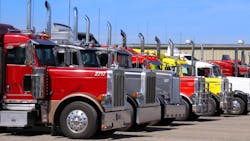Supply chain issues continue to plague the trucking industry, forcing many fleets to extend their asset lifecycles. Fleets operating older assets will see increases in maintenance and repair costs as they try to keep their older trucks on the road.
In addition, fleets may be examining their historical maintenance schedules and their parts purchasing decisions.
Fleets that have had three-to-four-year replacement cycles likely looked at ways to extend maintenance intervals for things like oil and filter changes. Now that these fleets have to extend their lifecycles, they must reevaluate their maintenance practices and see if they can keep their maintenance costs in check by playing catch up. This will entail addressing some deferred maintenance items.
See also: Making correct asset replacement decisions is vital
Extended lifecycles will require fleet maintenance managers to reevaluate their choice of replacement parts. Whereas inexpensive ruled the day for short-term lifecycles, extending the life of the replacement part as well as the asset will be a focus going forward. Preventive maintenance must not only address standard items such as oil drains, brakes, and tires but PMs must include parts, components, and sensors. Sensor maintenance will be critical because a fouled sensor can put a truck out of service.
With older assets it may be wiser to consider shortening maintenance intervals and bring vehicles into the shop more frequently as this could help spot problems in their early stages before they cause roadside breakdowns. By evaluating each asset’s TCO and ranking the assets from best performer to worst performer, maintenance managers can redeploy assets and keep poor performing assets closer to home.
See also: Asset health checks help fleets make the right decisions
Fleets are operating their assets under some rather unusual circumstances, so it makes sense to review “business as usual” practices when it comes to maintenance and repair to get the most out of the older trucks.
Patrick Gaskins, SVP of Corcentric Fleet Solutions, oversees both sales and operations for the company's fleet offerings. Gaskins joined the company in 2010, bringing more than 30 years of experience as a financial services professional in the transportation industry. He leads a team that works with a supply base of more than 160 manufacturers to help the country’s largest fleets manage all aspects of their fleet operations and fleet-related spend.
This article originally appeared in FleetOwner.com.
About the Author

Patrick Gaskins
Patrick Gaskins, senior vice president of Corcentric Fleet Solutions, oversees both sales and operations for Corcentric’s fleet offerings. Over the past 10 years, Gaskins has grown the fleet services area of Corcentric’s business by implementing a best-in-class asset management database and a data-driven approach to providing Corcentric clients with visibility into all areas of their fleet spend. He joined Corcentric in 2010, bringing over 30 years of experience as a financial services professional in the transportation industry. Gaskins leads a team of industry experts who work with a supply base of over 160 manufacturers to help the country’s largest fleets manage all aspects of their fleet operations and fleet-related spend. Gakins earned his BBA in Finance from the University of Miami, Florida, and his CTP certification from the National Private Truck Council.
